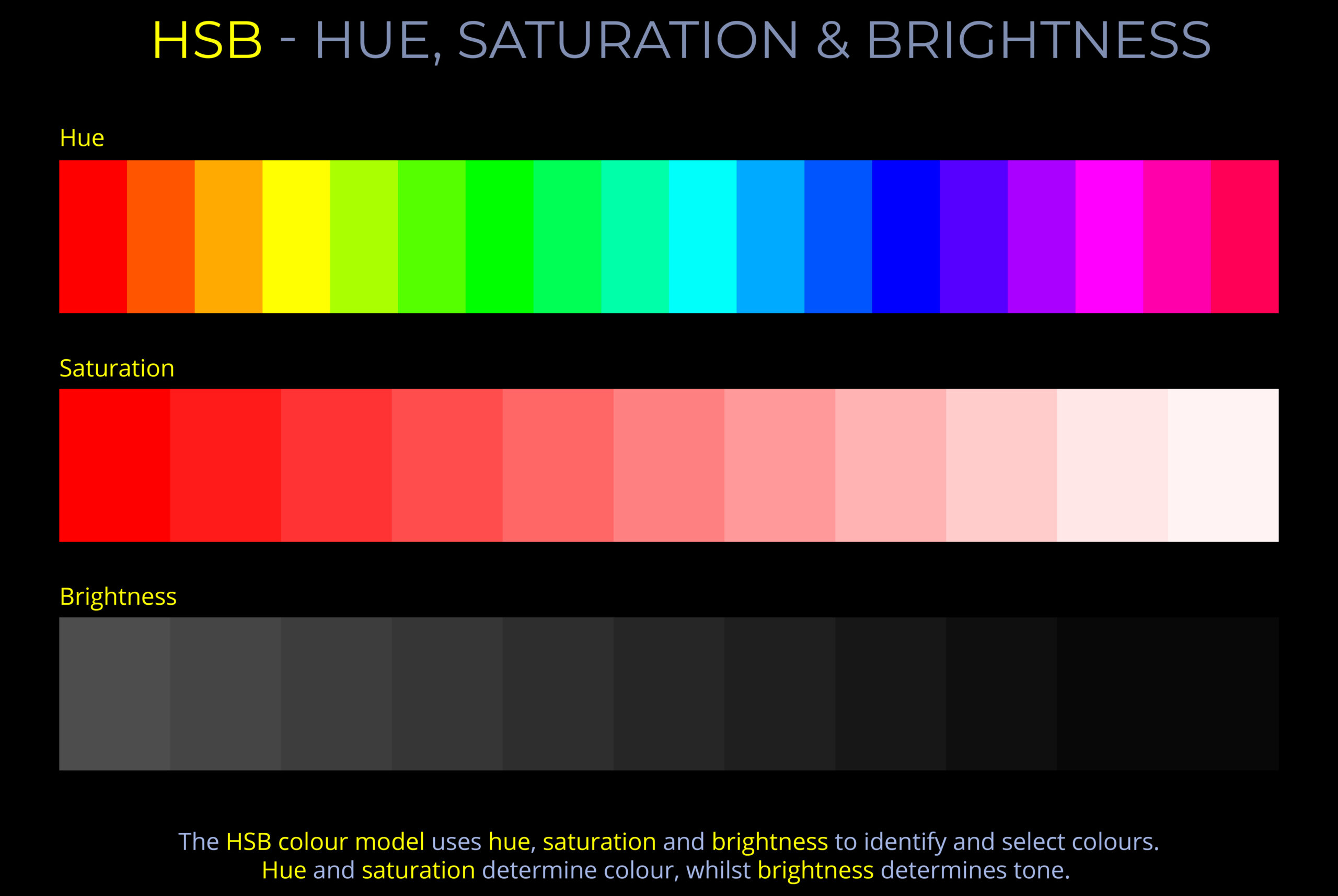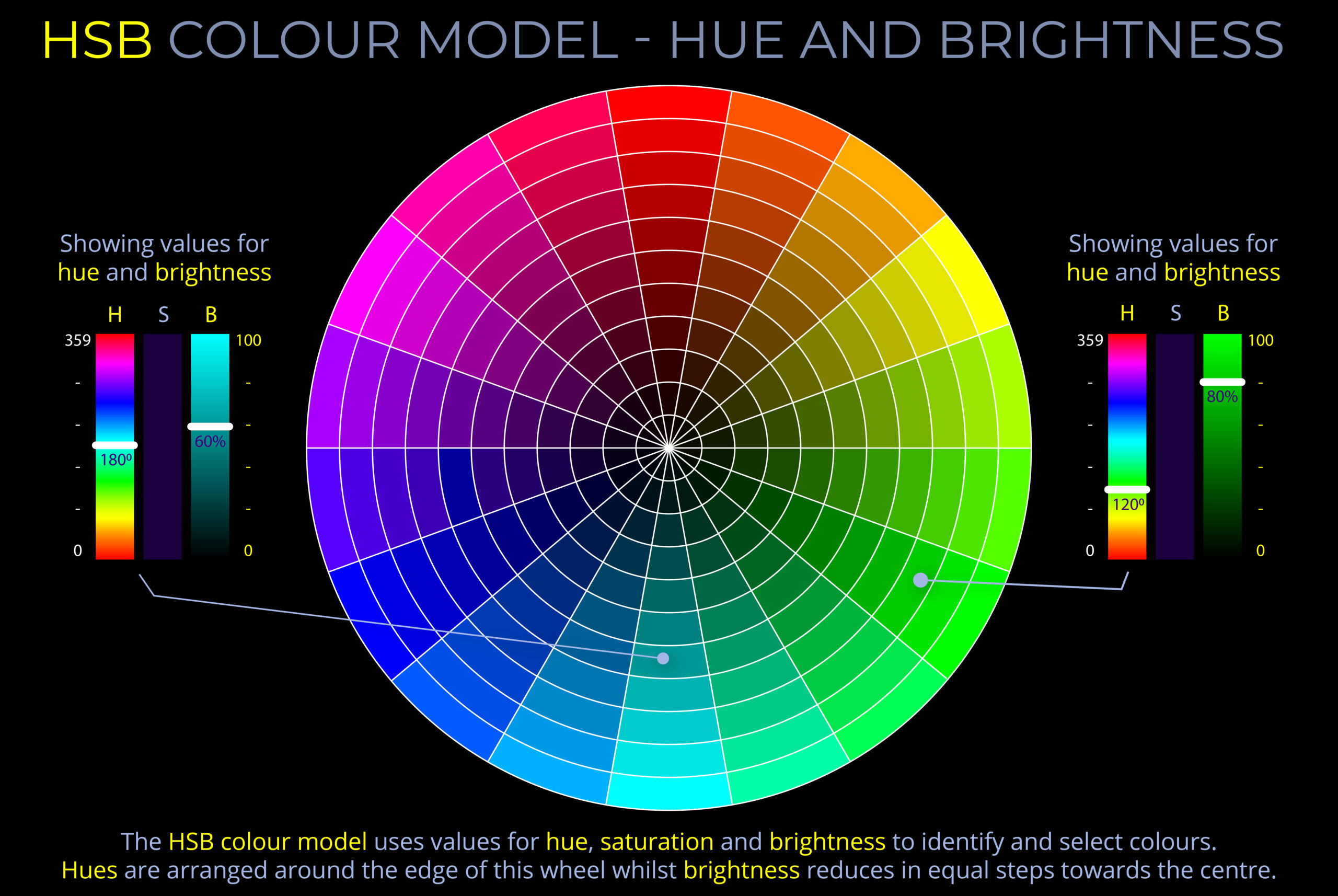In this resource, the terms brightness and colour brightness have distinct meanings. The first refers to a property of light, and the second to a property of colour as detailed below.
- In the first instance, brightness (as opposed to colour brightness) is used to refer to a property of light.
- Colour brightness is used to refer to how much colour something appears to emit or reflect towards an observer.
- When brightness is used in connection with the HSB colour model it is used alongside hue and saturation and refers to the method of selecting and adjusting colours in software applications such as Adobe Illustrator.
- The HSB colour model is a representation of colours that combines hue, saturation, and brightness components.
- In the HSB brightness represents the intensity or lightness of a colour, with higher values indicating brighter or lighter colours.
About brightness
- In this resource, the term brightness is associated with the intensity of light an object such as the Sun or a lightbulb emits.
- In everyday experience, we often gauge the brightness of a light source subjectively, by comparing it with the brightness of other known light sources.
- The brightness of a light can also be measured objectively using units like lumens or candela.
- Light travelling through a vacuum is not visible until it interacts with something such as our eyes or an object that reflects the light towards us, enabling us to perceive its brightness.
- The perceived brightness of a light source depends on the intensity and wavelength of the light and how the photoreceptive rod and cone cells in the human retina respond.
- Brightness, when used in this way, is the same as luminance.
- Luminance is a measure of the amount of light emitted, transmitted, or reflected from a particular area in a specific direction. It is used to quantify the intensity of light that is perceived by the human eye from a particular direction.
- Our eye’s photoreceptors, especially the rod cells which are more sensitive to light intensity, play a crucial role in our perception of brightness. Rods are more abundant and distributed throughout the retina, and they function mainly in low light conditions to help us perceive the brightness or lightness of an object, but they can’t distinguish colour.
- On the other hand, our perception of colour is based on how different wavelengths of light stimulate the three types of cone cells in our eyes. These cone cells are sensitive to short (S, which corresponds to blue), medium (M, corresponds to green), and long (L, corresponds to red) wavelengths of light. The combination of signals from these three types of cone cells allows us to perceive a broad spectrum of colours. Colour perception depends not just on the light’s intensity, but on its spectral composition – what mix of wavelengths it contains.
About colour brightness
- In this resource, the term colour brightness is used to describe how things appear to a human observer in terms of their perception of colour.
- Colour is what humans perceive in the presence of radiated or reflected light.
- The brightness of the colour of an object or surface (colour brightness) depends on the wavelengths and intensity of light that illuminate it and the amount of light it reflects.
- The colour brightness of a transparent or translucent medium may be influenced by the wavelengths and intensity of light that pass through or reflect off it and the amount it transmits or reflects.
- Colour brightness is frequently influenced by the contrast between how a colour appears to an observer under well-lit conditions and its more subdued appearance when in shadow or under poor illumination.
- The perception of colour brightness is also influenced by hue, as certain hues appear brighter than others to human observers. For example, a fully saturated yellow may appear relatively brighter than a fully saturated red or blue.
About brightness & colour models
- The term brightness is often used in association with a specific colour model.
- Examples of colour models include:
- The HSB colour model uses the term brightness alongside hue and saturation.
- Some colour models don’t use the term brightness at all, so when we change from one colour model to another it’s best to change our terminology as well.
About the HSB colour model and colour brightness
The HSB colour model is an additive colour model used to mix light. Subtractive colour models are used to mix pigments and inks.
- The RGB and HSB colour models differ only in the way colours are represented in terms of colour notation and handled in software and applications.
- Both the HSB and RGB colour models involve mixing red, green, and blue light to produce other colours.
- HSB is popular because it offers an intuitive method for selecting and adjusting colours within applications like Adobe Creative Cloud, which is commonly used in design, photography, and web development.
- The HSB colour model can be used to describe any colour on a TV, computer or phone screen.
In the HSB colour model:
- Hue refers to the perceived difference between one colour and another and accounts for colour names such as red, yellow, green or blue.
- Hue can be measured as a location on a colour wheel and expressed in degrees between 00 and 2590.
- Saturation refers to the perceived difference between one colour and another in terms of purity.
- Saturation is measured between a fully saturated colour (100%) and an unsaturated colour that appears dull and washed out, eventually reaching a monochromatic grey tone (0%).
- A fully saturated colour is produced by a single wavelength or a narrow band of wavelengths of light.
- On HSB colour wheels, saturation is typically shown to increase from the centre to the circumference.
- Brightness (colour brightness) refers to the difference between a hue that appears bold and vivid at maximum brightness (100%) and then appears progressively darker in tone until it appears black at minimum brightness(0%).
- Colour brightness is often evident in the distinction between how a colour appears to an observer under well-lit conditions compared to its more subdued appearance when in shadow or under poor illumination.
- In this resource, the terms brightness and colour brightness have distinct meanings. The first refers to a property of light, and the second to a property of colour as detailed below.
- Brightness (as opposed to colour brightness) is used to refer to a property of light.
- Colour brightness is used to refer to how much colour something appears to emit or reflect towards an observer.
- When brightness is used in connection with the HSB colour model it is used alongside hue and saturation and refers to the method of selecting and adjusting colours in software applications such as Adobe Illustrator.
- The HSB colour model is a representation of colours that combines hue, saturation, and brightness components.
- In the HSB brightness represents the intensity or lightness of a colour, with higher values indicating brighter or lighter colours.


